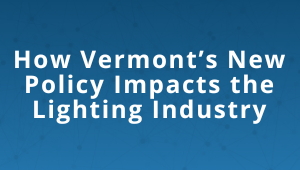
The last few months have brought some heavy-hitting changes in the lighting industry. On the tails of the implementation of DLC 5.1 standards, policy news out of Vermont foreshadows the future of lighting. Back in May, Vermont’s state legislature passed a law saying that 4’ linear fluorescent tube lighting must be phased out by January 2024. This makes the Green Mountain state the first in the United States to adopt a policy of this kind.
The justification given for this new law is the toxic effect that mercury, which is present in fluorescent tubing, can have on both people and the environment. Individual fixtures have little risks if in perfect condition, but broken fixtures or improperly disposed of bulbs can do harm, especially when there are many fluorescent tubes in use. Mercury risks are fairly well-known today, but Vermont cites the increasing availability of LEDs as one of the key reasons for making this move now. LEDs do not contain mercury, are more efficient, last longer, and now have the least life-cycle cost due to energy savings quickly recouping a higher cost of installation. As far as Vermont is concerned, this means that there is no longer a justification for fluorescents to remain dominant. This ruling comes after a previous advisory from the Vermont Department of Environmental Conservation, which restricted the sale of screw-in CFLs containing mercury; they will stop being sold in February of 2023.
While Vermont is the first state to restrict fluorescent tubing, policies designed to encourage replacing outdated light fixtures with newer, more efficient models have been gaining traction. California, for example, has Title 20, which lists efficiency requirements for all lighting products sold within the state. Previous national rulings have focused on the conclusion of incandescent bulb sales. The U.S. federal government also recently instituted guidelines that would prohibit the manufacturing of incandescent bulbs, with the goal of being phased out entirely by 2023. You can read more about these energy efficiency standards here.
Vermont certainly will not be the last to implement this policy, either. Overseas, all fluorescent bulbs in the European Union will be phased out by 2023 - though they will still be exported by those countries. It is likely that, as these measures gain traction on the state level, we will see something done at the national level in the coming years. These early fluorescent lighting policies will shape the future of the lighting industry in a dramatic way. Vermont’s messaging hinges on the greater availability of LEDs on the market, so manufacturers should expect to see these products overtake older fluorescent bulbs soon. Despite this availability, fluorescents account for 70% of linear lighting sales, so reducing their availability will change what lighting looks like. Previous measures, such as the Energy Independence and Security Act of 2007, focus primarily on those bulbs used residentially. While these bulbs may appear in commercial settings, fluorescent tubing is far more common, found in office buildings, schools, storefronts, and more. By phasing them out, these large buildings will have to adapt by embracing LEDs - a move that will make buildings more efficient and safe from potentially harmful effects of mercury, while saving owners money in the long run.
1. https://dec.vermont.gov/sites/dec/files/wmp/SolidWaste/Documents/CFLampFactSheet.pdf
2. https://www.energy.ca.gov/programs-and-topics/programs/appliance-efficiency-program-outreach-and-education
3. https://eeb.org/eu-bans-toxic-lights-continues-exportation/
4. https://energynews.us/2022/07/20/vermont-moves-to-become-first-state-to-phase-out-linear-fluorescent-lights/
5. https://www.epa.gov/mercury/how-energy-independence-and-security-act-2007-affects-light-bulbs
.png?width=500&name=2019%20e%20news%20spotlight%20logo%20(1).png)



